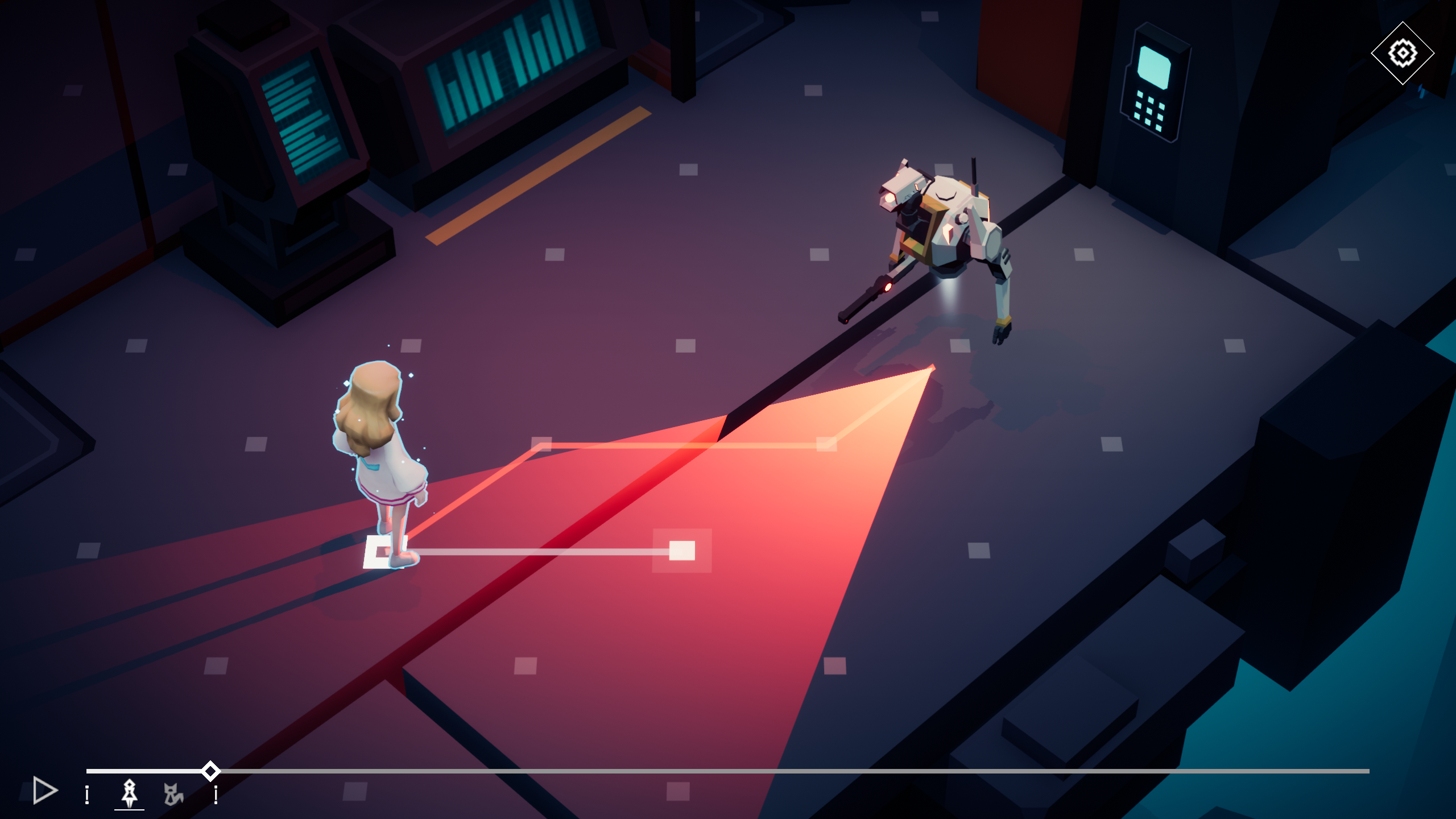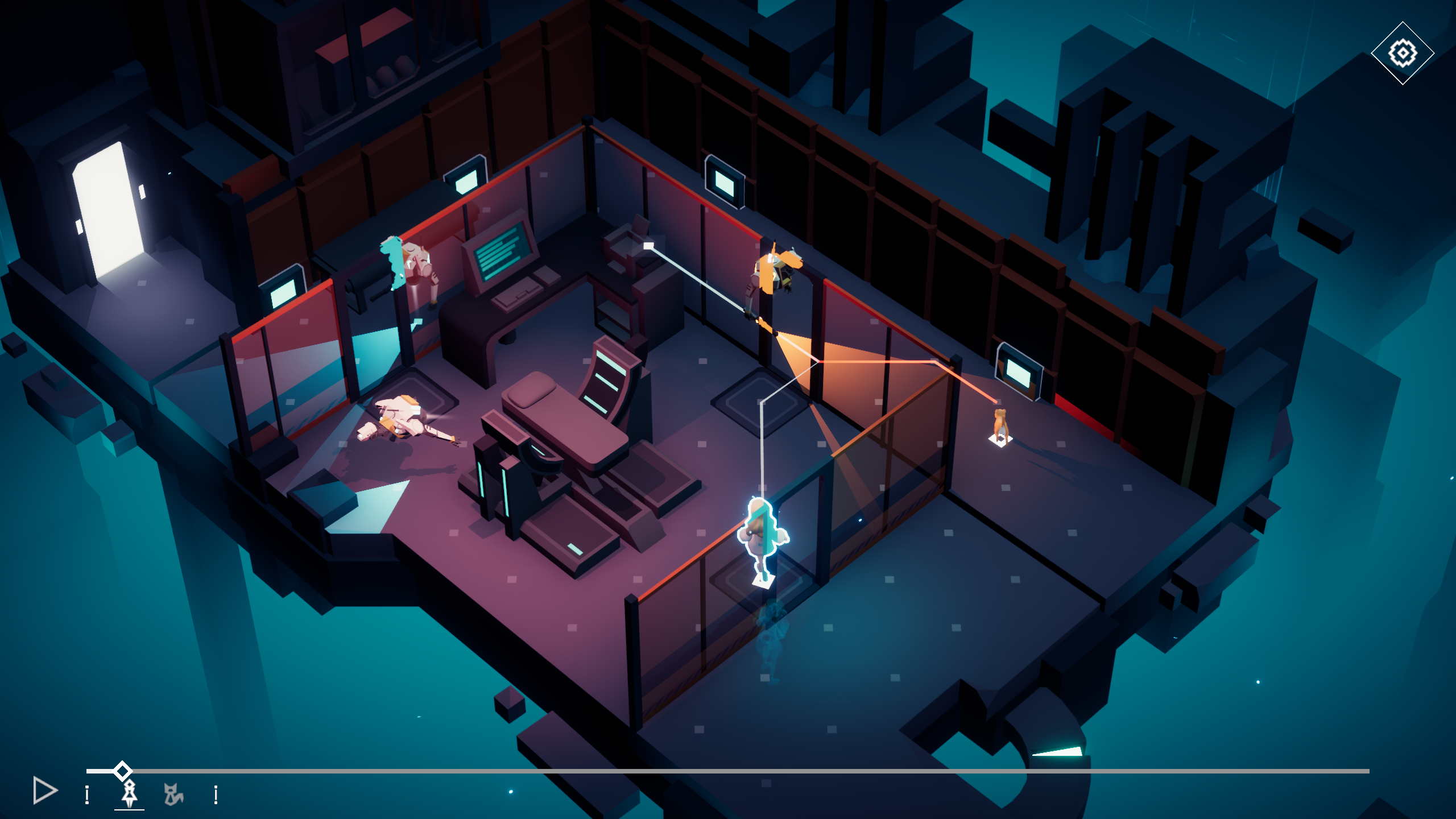Our Verdict
A time-bending puzzle game clever enough not to be just another time-bending puzzle game.
PC Gamer's got your back
What is it? A stealth puzzle game in which time can be sped up and rewound.
Expect to pay $19/£14.49
Developer Urnique Studio
Publisher Urnique Studio, Milk Bottle Studio
Reviewed on RTX 2070 Super, Intel i5-9600K, 16GB RAM
Multiplayer: None
Link: Official site
At a glance, Timelie looks unremarkable: a puzzle game where time can be reversed to back up a tumble through a crumbling walkway, Prince of Persia-style. But that's not really what its timeline-scrubbing is for, and there are some clever surprises that make it worth a one or two-sitting playthrough.
Timelie, which both my brain and computer frequently autocorrect to "timeline," would've been considered indie chic in 2008, but its look is commonplace today: A crisp, untextured world of right angles. It's attractive, but boring. The narrative is vague, sleepy, and littered with iconography (a birdcage, a lock and key, and so on). I wasn't gripped by its metaphors, but I didn't need any powerful motivation to help the anime-looking girl escape from robot-guarded mazes. After sitting through Volume's blah Robin Hood allegory, I was happy for a puzzle game that's content with voiceless cutscenes and sad-sounding bell music. The cat is cute, though, and cute cats are always welcome.
The puzzles are rooms in a generic-feeling Medical Science Facility, and your goal is to get the girl, and sometimes the cat, to each room's exit. Blocking your way are closed doors and patrolling robots who'll chase down your protagonists and bonk them on the head if they spot them. Sound doesn't factor into stealth, so you can stand right next to robots so long as they can't see you.

Here's the time twist: You can scrub the timeline forward and backwards like you're watching a YouTube video, observing the robot's patrol patterns. At any point in the timeline, you can issue new commands to the girl and the cat, or clear commands you've already made. If either of them is caught by a robot, the timeline ends there and you can't push into the future anymore, so you have to scrub back and change an action to stay out of sight.
It's a really nice way to include a fail state that isn't a fail state. If you make a mistake, you just rewind and change a few clicks to try something new. If your plan was wrong from the very first move, it means scrubbing all the way back to the beginning of the level and starting over, but it rarely feels tedious because you never have to watch your plans play out in real time. You can just drag time into the future to find out that, nope, a robot's going to bonk her on the head if you do that.
A very minor gripe: The interface is at the very bottom of the screen, and on my 27-inch monitor it disappeared from my focus to the point that, for a while, I didn't notice that there are helpful icons to tell you if you have the girl or the cat selected (something the white glow around them doesn't communicate as clearly as it could). I think that PC game interfaces should leave a little space between important info and the edges of the screen, or be customizable—but that's a pet peeve at best, so don't let my UI sticklerism put you off.

Aside from using foreknowledge of patrol patterns to stay out of sight, you'll have to find ways for the girl and cat to cooperate, distracting guards and opening doors for each other. The cat can meow to attract bots, and the girl can collect orbs which allow her to repair parts of the level. The more complicated puzzles involve manipulating bot patrol patterns with tactical meows, trapping them in rooms with decoy maneuvers and switches, and harrowing dashes where a vaporizing wall sweeps through the level as time passes.
Some puzzle solutions are finicky and a bit irritating. At times, you just have to guess at whether the girl can move a certain number of spaces and stay out of a bot's view, or if having the cat meow one square over will have a totally different outcome. Others are tutorial-level easy. But plenty of Timelie's stages hit the sweet spot between mechanical and conceptual complexity that makes figuring them out feel satisfying, like unpicking a tricky knot. And things get really knotty near the end, in ways I won't spoil.
Suffice it to say that Timelie delivers a few good time travel tricks over the course of its four-or-so hour runtime, wrapping things up before it can get stale. I was a little disappointed that it didn't subvert my expectations in any wilder ways at the end, and some of the late levels are conceptually cool but not all that fun to solve. Overall, though, Timelie is a nicely-made puzzle game. It's subdued atmosphere pairs well well with killing time before bed, which is how I played through it in one night and stayed up later than I meant to.
A time-bending puzzle game clever enough not to be just another time-bending puzzle game.

Tyler grew up in Silicon Valley during the '80s and '90s, playing games like Zork and Arkanoid on early PCs. He was later captivated by Myst, SimCity, Civilization, Command & Conquer, all the shooters they call "boomer shooters" now, and PS1 classic Bushido Blade (that's right: he had Bleem!). Tyler joined PC Gamer in 2011, and today he's focused on the site's news coverage. His hobbies include amateur boxing and adding to his 1,200-plus hours in Rocket League.


